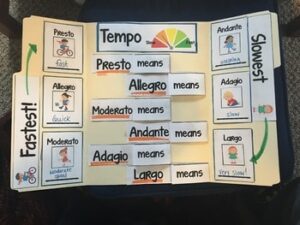As music teachers working with young students, we’re always looking for tools that make abstract concepts come to life. One of our favorite go-to activities? Lapbooks.
These interactive, DIY folders are more than just crafts—they’re powerful teaching tools. And when used in lessons or at home, music learning with lapbooks can boost understanding, memory, and joy in the learning process.
What Is a Music Lapbook?
A lapbook is a personalized learning folder filled with mini booklets, flaps, diagrams, pockets, and visuals. Each section covers a concept—like rhythm, note values, instrument families, or dynamics.
Because they’re made by the student (with some guidance), lapbooks encourage:
- Hands-on engagement
- Personal ownership of content
- Creative exploration of music theory and terms
Lapbooks are especially effective with younger learners or visual/tactile students who benefit from movement and color in their lessons.
5 Ways to Use Lapbooks in Music Lessons
Here are some tried-and-true ways to use lapbooks in your music lessons:
- Build a “Music Terms” folder: Each flap defines a different musical word—like forte, legato, or crescendo.
- Create an instrument family sorter: Students group brass, strings, woodwinds, and percussion.
- Design rhythm flashcards inside the lapbook to clap and match.
- Track practice goals using a spinning wheel or reward chart built into the folder.
- Visualize the grand staff by building a flap with labeled notes or treble/bass clef pop-ups.
Not sure where to start? Homeschool Share offers templates and free printable resources that work beautifully in music-themed lapbooks.
Why Lapbooks Support Long-Term Learning
Incorporating lapbooks into lessons lets students interact with theory concepts again and again. They don’t just hear the word “dynamics”—they flip the flap, see an example, color-code it, and create a memory around it.
For private teachers, lapbooks also offer a quick visual review tool and a way to keep students engaged between activities or during short breaks.
Related Reading
Curious about more ways to blend creativity into lessons? Don’t miss our post on teaching music theory in fun and interactive ways.
FAQ: Music Learning with Lapbooks
What age is best for lapbook use?
Lapbooks are ideal for ages 5–12, though even older students benefit from the visual and creative elements.
Do I need to create the lapbooks myself?
Not necessarily. You can find free templates online or build them together with your student as part of the lesson.
Are lapbooks only for homeschoolers?
Not at all! They’re used by private teachers, classroom educators, and parents looking to reinforce learning at home.
